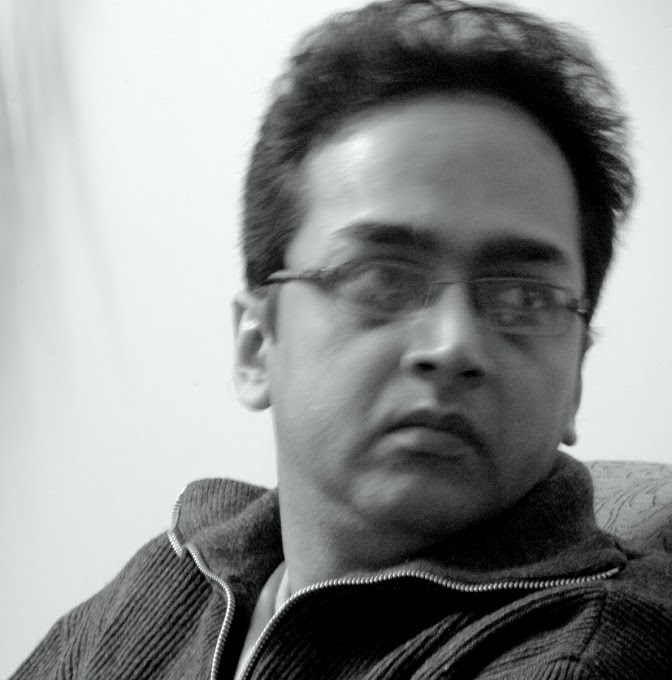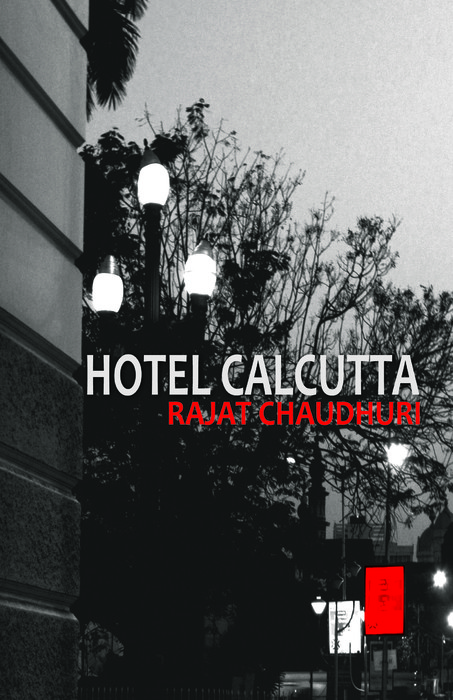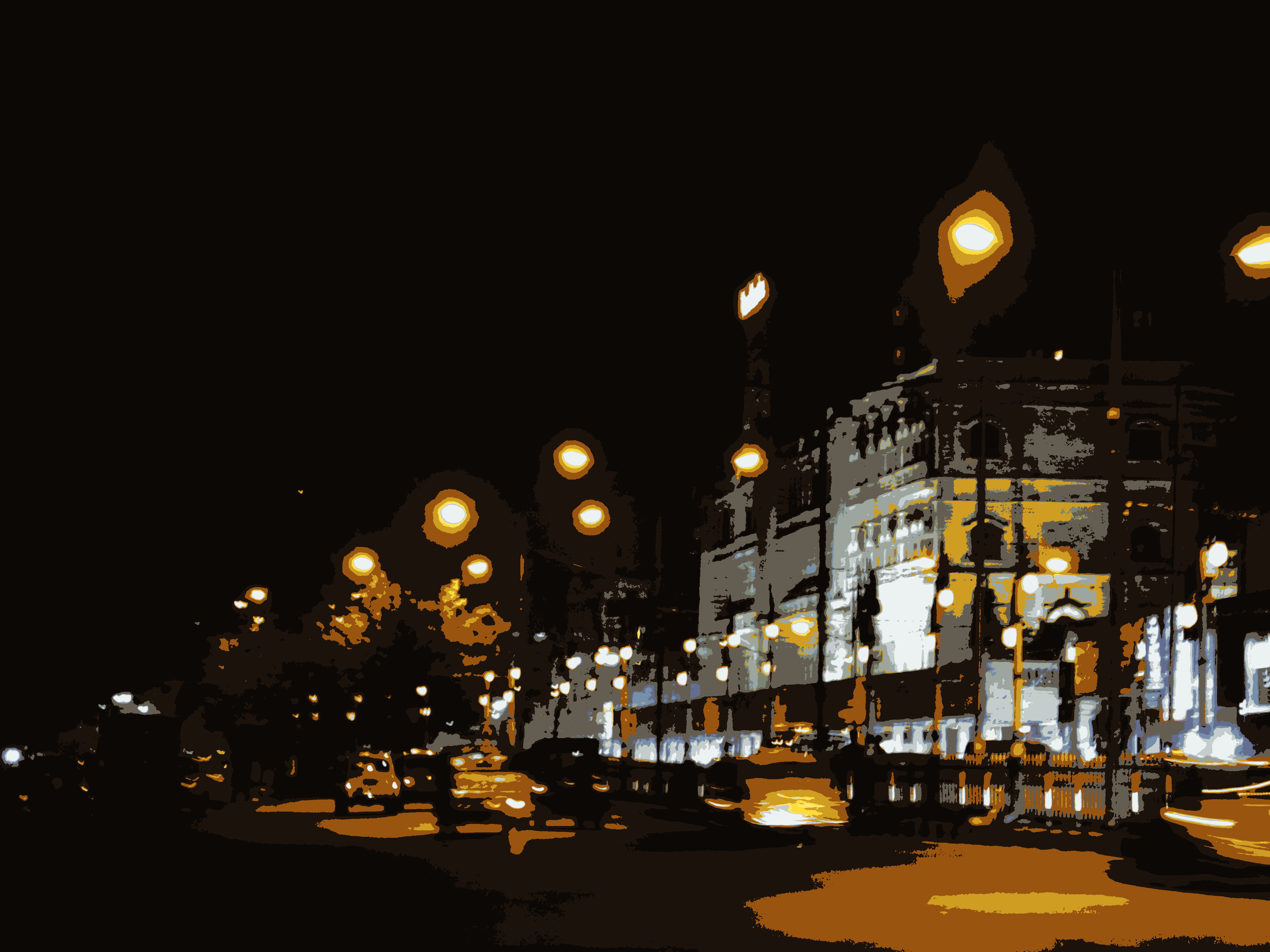Rajat Chaudhuri’s Hotel Calcutta has just been published (Niyogi Books, 2013). He lives in Kolkata, and besides his novels, he has also written short stories, essays and book reviews. The few questions I asked Rajat below are really not enough to convey the richness and variety of his writing work but his answers I thought give a good overview of a writer who deserves to be widely read. Indeed in his writing, he makes an eloquent plea that a world created out of stories can be a rich, immense treasure filled one, filled with surprise knowledge and strange human connections. Hotel Calcutta appears to be a metaphor in this sense. It is a threatened place, vulnerable in the face of insistent commercialization and it appears it can be saved only if a ‘wall of stories’ is built around it, a wall immune and thus invisible to the malevolent land sharks and their bulldozers waiting nearby.
Here’s Rajat in his own words.
-
You wrote Amber Dusk in 2007 and now Hotel Calcutta. Did you consciously choose this gap? Sometimes writers get worried especially after the first novel, and they think they have to move onto the next one?
Thanks for asking this question. There were two things at work here, well maybe more than two. Between writing the first novel and getting it published there was a two year gap. Amber Dusk was a 370 page doorstopper and writing it took the better part of four years. So I was completely knackered by the time I finished and took a holiday from writing. Then one holiday slipped into the next and in between there were friends, partying and faffing around while pretending to be a kind of activist by day. Having written the first book the dominant feeling was that one has to read a lot more and gather more experience before planning another book. So side by side with the partying and pretend-activism I had been meeting people, travelling and reading eclectically. This went on for a couple of years.
Then one day I began to miss this joy of creating characters, making them love and fight and so started working on this novel about madness. And in the gaps of writing that novel which is now in the final draft, I was penning the odd short story, getting these published in little magazines and webzines in India and abroad. During this time I was lucky to get selected for a writers’ residency at Sangam House which provided me the opportunity to write more short stories and plan another book. Some of these stories are part of this new book – Hotel Calcutta. So to answer your question – I was conscious that I needed to read and gather more experience before thinking of another book and that partly explains the gap. There was really no hurry to move quickly to the next book.
-
Somehow I found the theme of Hotel Calcutta interesting. Hotel based novels are fascinating, just as those involving people in a certain setting. There’s Chowringhee of course? So tell us about yours and the making of it?
Yes, people in closed or semi-closed settings or on a journey, fighting their battles against time or a present danger has been a favoured theme of literature. Balzac put Père Goirot and some of his other characters in Madame Vauquer’s boarding house, Calvino assembled his mute travellers in a castle beside a forest where they tried to figure out what had happened to them while Yann Martel just had Pi and Richard Parker on a boat on the Pacific. This tightening up of the setting allows among other things suppressed material – psychological, spiritual, existential – to rise to the surface giving a different dimension to the story and facilitating extensive character studies. This was one of the reasons why Hotel Calcutta, at least the frame story, had to happen within the hundred year old Calcutta hotel.
Of course hotels come readymade with intriguing possibilities. Who was the shifty-eyed man who rarely left his room? Whose footsteps did the American lady hear that night? Why were the war historians behaving like detectives? What went on behind the closed doors of the West Wing suite? Then there is this framing narrative about the real estate company that wants to demolish the hotel to build a shopping mall and how the guests and the staff, keeping faith in the Buddhist monk’s prophesy, tell stories to each other to protect the old hotel.
And yes Chowringhee was there as there was Arthur Hailey’s Hotel. Stanislaw Lem’s Futurological Congress, Balzac’s Père Goriot and several other novels were also there on my mind when I began to think about the setting for this book. I recently discovered that the Italian translation of Chowringhee is titled Hotel Calcutta though the similarities between these two books don’t go far beyond that. In fact it’s a kind of obvious name but one day, walking about in a neighbourhood of north Calcutta, I found that there is, in fact, a real Hotel Calcutta in this city!
Sankar’s Shah Jahan Hotel in Chowringhee is modelled on the Grand Hotel. My inspiration for the setting was a number of smaller places like the Fairlawn hotel and the Astor hotel. One of these has been around for more than two centuries! This last one has a wonderful open air bar in a garden which I used to visit often.
-
Your book of stories has one set in Holland and another set in a city with a hotel called Broadway, and the characters appear universal too. The stories move across genres too. And still you decided to call it ‘Hotel Calcutta’ – is that significant, emblematic in some way?
First of all I would like to share with you the fact that I originally conceived this book as a story cycle which, as you know, is a very old storytelling tradition to be found in works like Kathasaritsagara, Arabian Nights or Canterbury Tales. In modern times writers like James Joyce and Italo Calvino have experimented with some form or other of this linked storytelling. While writing my own story cycle, I found that the frame story was getting busier by the day and taking on a life of its own. I also realised that the stories rather than being linked directly or thematically, had independent existences. This made me think whether to call this book a story cycle, a book of stories or a kind of novel (some people have used the term `composite novel’ for such works). Unable to arrive at a definite conclusion I call it a novel by day and a book of stories (or story cycle) by night!
This suits the scheme of things though. In a hotel, stories have to come from all sorts of places and backgrounds, just as the guests can be from anywhere. Just as there are all kinds of characters telling stories, the characters within these stories come from different backgrounds too.
In Hotel Calcutta there are indeed some stories that are from far flung places – Calcutta, Delhi, southern India, New York, Amsterdam etc. You also must have noticed that more than half of the stories are in fact based in Calcutta. In some of these the setting is hinted through street names while in some others the association is there for the reader to discover. Broadway for example is an old Calcutta watering hole that may not have made it to the Lonely Planet but is a must visit for its spare but charming ambience. I like to imagine Hotel Calcutta – the book, the hotel and the city whose absence in the frame story is meant to reinforce its presence in the reader’s imagination – as a river, with stories flowing into it like tributaries, while other stories meander away from it on their journeys into the world. And as you rightly suggest the title Hotel Calcutta is also emblematic in the context of the frame story which is about the struggle to prevent the destruction of Calcutta’s past.
4. You are a photographer too, experimenting with light and shade. Do these aspects play a role in the novel?
Photography is more of a hobby while writing is a serious passion, so much so that it is almost a disease and once in a while one thinks of getting cured and starting to focus on building that cottage in the hills! I am deeply interested in the visual arts especially painting and because I cannot paint, my interest in photography stems from the unfulfilled desire to wield the brush. In fact the kind of photos I make are more leaning towards fine art photography where among other things, the digital dark room has an important role to play. My writing does feed from photography but I feel it’s more directly influenced by painting. Light and shade yes but more of the shade. More of the darkness, more of the mannered work, more elements of the surreal. Think Magritte, think El Greco, think Tintoretto’s Last Supper even consider Hieronymus Bosch. They are my inspirations. The first story in Hotel Calcutta has Rembrandt’s The Night Watch as an important plot device.
-
And some of your essays on Calcutta have the flâneur ‘s perspective, or so it seems to me? There are some writers who are devoted to a city, and Calcutta seems to have several already. Did this make you sort of more self-aware and conscious?
I guess you mean the flâneur as photographer in that case I should be talking about my photo essays about Calcutta. Yes I do quite a bit of street photography and naturally this is real flâneur territory. This whole idea about strolling around the city, steeping yourself in the visual experience, is great fun and most of my Calcutta photos come from that. But as I said before I do like to manipulate this material in the digital darkroom and that way modify the city in my imagination, trying perhaps to reveal stuff that is invisible. So in my stories too you will find these people-watching, crowd-gazing, street-strolling characters who have the attitude of a flâneur till they are drawn into their own peculiar circumstances.
I am not sure if we should call it devotion but yes there are so many writers writing about Calcutta both in English and Bengali and some of them keep coming back to her again and again. This is good for Calcutta because if the city really dies out, as a past Prime Minister had predicted or turns into a city of shopping malls and high rises with the rest of the populating living in abandoned metro railway tunnels or even if it metamorphoses into a London (a somewhat better turn of events this last one) as expected by those in power, then at least we will have these books to read by the fire of kerosene lamps.
When so many writers are writing about a city it does mean something. For me it’s not only writers writing about Calcutta but writing about the city everywhere. Paul Auster’s New York, Joyce’s Dublin, Balzac’s Paris, John Kennedy Toole’s New Orleans though historically and geographically far removed, do mould our understanding of the city as subject of literature, perhaps influencing how one engages with the urban experience through writing and also otherwise.
-
Related question, it’s also brave because you have these giants – writing on Calcutta, isn’t it?
Yes. Right from Kaliprasanna Singha through Sunil Gangopadhyay, Nabarun Bhattacharya and others writing in Bengali (just to name a few) and Amit Chaudhuri, Amitav Ghosh and I hear Jhumpa Lahiri will be publishing a new book on Calcutta soon, it looks like a big boys club, doesn’t it? Did I say, it needs courage to write about Calcutta in the shadow of these giants? No it does not. One finds their presence reassuring. One can rest in their shadows and set out on one’s journeys of re-discovering the city.
-
You are a bi-lingual writer? There aren’t many who write both Bangla and English, right, while for instance, there are more such writers bilingual in Marathi and English? Why do you think so?
Yes I write a bit in Bengali too and will be publishing a book of stories later this year.
I don’t know why there aren’t many who write fiction in Bengali and in English. In fact there is such a dearth of English fiction writers based in Calcutta. Perhaps this has to do with language education policies introduced in West Bengal (English was no more compulsory in the primary level) in the late seventies and early eighties that had continued for a decade.
-
Who are your influences? Who do you like reading?
The possibility of influence gives birth to anxiety. This in turn creates the need to swerve off from the path of influence of past authors, and try and be a little original. We all know about Harold Bloom’s important work on influence and misreadings. I find that there are certain authors whose writing jumps at you saying, `take me’ and they are simply irresistible which may or may not mean that they are good in my bed. In any case there are a few such authors whose books I don’t read at all because I feel the temptation to get influenced by them and secretly emulate them is just too strong. Perhaps one way to cancel out influences is to read widely and eclectically. I have liked reading Cervantes, Flaubert, Zola, Dostoevsky, Aldous Huxley, Bulgakov, Herman Hesse, Borges, Poe, Hemingway, Thomas Pynchon, Saramago, Paul Auster, Italo Calvino, Kafka, Kundera, Rushdie, Ghosh, Chaudhuri, V.S. Naipaul among many others. Then there is this generation of extremely talented younger Indian writers writing literary fiction whose books I enjoy.
-
You work on the northeast, and in a non-profit organisation. Do you necessarily have to lead a dual life, separating your writing from this, or is there a seamless intermeshing?
This was some years back. We do run a small non-profit but over the years I have delegated most of the work to others and we only do projects that we really like. I realise that writing plunders my store of energy leaving me quite drained. I am not comfortable switching from a day job to sit down to write at night though I know there are writers who can handle that quite well. I have heard folks say that the day job gives you experience that can enrich your writing. They may be right. As for me, I have other methods and in this country where stories abound it is often just a matter of stretching out your hands to catch the raindrops falling from the sky.
Anu Kumar’s most recent novel for older readers, ’It Takes a Murder’ ( http://www.hachetteindia.com/TitleDetails.aspx?titleId=32055) releases this month and is published by Hachette India. More details of this book and her other books and writings are at anukumar.org









Lovely interview with Rajat Chaudhuri about his new book Hotel Calcutta, his photography and his writing..
He has the golden words to share with love.
Cheers!
Sumit
Let me see if i can find it over crossword , nice cover anyway….